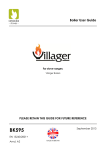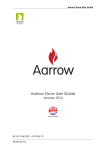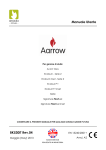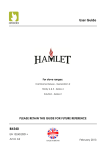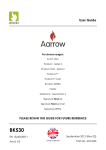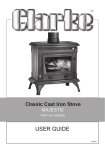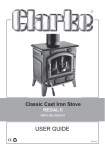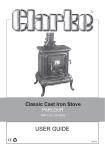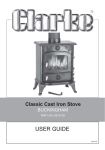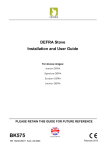Download Aarrow Acorn 4 Installation guide
Transcript
Dry Stove Installation Guide Dry Stove Installation Guide January 2014 BS EN 13240:2001 +A2:2004 CE BK545 Rev06 Dry Stove Installation Guide Arada Ltd January 2014 Please carefully read through the entirety of this installation guide before commencing installation. Should you have any questions about our stoves that are not covered in this manual, please contact the Arada retailer in your area, or call our technical support department on 08448 567181. You should retain these instructions for future reference. Arada has a policy of continuous product development and therefore we reserve the right to amend specifications without prior notice. Due to printing cycles, items or options may be described before they are generally available or after they have ceased. Please check with your retailer or dealer if you are unsure about any aspect of your stove, its installation or correct use. Dry Stove Installation Guide Contents 1 Warnings 1 2 Health and Safety 1 3 Installation Requirements 3.1 Hearths and Recesses . . . . . . . . . . . . . . . . . . . . . . . . . . . 3.2 Combustible Materials . . . . . . . . . . . . . . . . . . . . . . . . . . . 3.3 Air for Combustion . . . . . . . . . . . . . . . . . . . . . . . . . . . . . 2 2 3 3 4 Flue and Chimneys 4 5 Installing the Stove 5.1 Removing the door . . . . . . . . . . . . . . . . . . . . . . . . . 5.2 Removing the throat plate and liners . . . . . . . . . . . . . . 5.3 Assembling the grate bars . . . . . . . . . . . . . . . . . . . . 5.4 Fitting the spigot outlet to the stove . . . . . . . . . . . . . . . 5.5 Connecting the spigot outlet to the flue system . . . . . . . 5.6 Sealing of terminals . . . . . . . . . . . . . . . . . . . . . . . . . 5.7 Sealing the back and base of inset stoves to a fire surround 5.8 Fixing 5kW inset stoves to the chair brick . . . . . . . . . . . . 5.9 Adjusting the self-levelling feet (if applicable) . . . . . . . . . 5.10 Firebox liner panels . . . . . . . . . . . . . . . . . . . . . . . . . 6 Commissioning the stove BK545 Rev06 . . . . . . . . . . . . . . . . . . . . . . . . . . . . . . . . . . . . . . . . 6 6 6 7 7 7 8 8 8 8 9 9 Dry Stove Installation Guide 1 Warnings It is a legal requirement that the installation of all new or replacement, wood or solid fuel heating appliances must obtain Building Control approval from your local authority. This can be done by using a qualified heating engineer, affiliated to a government approved competent persons scheme such as operated by HETAS. If in doubt, contact HETAS Limited, telephone: 0845 634 5626 or visit www.hetas.co.uk. You can also consult your local buildings inspector / controller. All local regulations, including those referring to National and European standards, need to be complied with when installing the appliance. This stove should not be installed into a chimney that serves any other heating appliance. Any manufacturer's instructions must not be taken as overriding statutory requirements. Arada Ltd will not be responsible for any consequential or incidental loss or injury however caused. Any further warnings in this document will be marked out in a box such as this one. Ignoring the warnings could lead to damage/injury to persons and/or property. 2 Health and Safety Before any installation work is undertaken consideration must be given to the Health and Safety at Work Act 1974. Safe working practices should be followed at all times. Please consult health and safety guidelines for advice on handling heavy and/or large items. During installation ensure that adequate precautions are taken to avoid unnecessary risk to yourself or any householder. The danger from the caustic nature of fire cement, should be avoided by using these accepted methods: Wear gloves when handling fire cement. Wear goggles when chiseling or looking up chimneys. BK545 Rev06 1 Dry Stove Installation Guide This stove contains no asbestos. If there is a possibility of disturbing any asbestos in the course of the installation then please seek specialist guidance and use appropriate protective equipment. 3 3.1 Installation Requirements Hearths and Recesses The stove should be installed on a surface with adequate load bearing capacity. If the existing construction does not meet this prerequisite, suitable measures (e.g. load distributing plate) should be taken to achieve it. Please pay particular attention when examining existing building work for suitability to meet the following requirements. When installing an inset stove, hearths should have a sufficiently flat surface to allow a good seal to the stove body to be created during its installation. Stonework, uneven bricks etc. may need further work to ensure that this can be achieved. Any voids behind an inset stove should be filled with vermiculite or similar. The stove should be installed on a non-combustible surface not less then 125mm thick (conforming to Building Regulations unless otherwise specified) of suitable load bearing capacity and heat resistance. Allowances should be made for the expansion and contraction of any materials which are fitted up to and near the appliance. Dimensions of the constructional hearth for all stoves should project at least 500mm forward of the front of the appliance and 150mm at the sides. The surface of the hearth should be free of combustible materials. The superimposed hearth for all installations should project at least 225mm forward from the front of the appliance and 150mm either side of the edge of the appliance. In most buildings with solid concrete or stone floors, the requirement will be met by the floor itself, but mark the hearth to ensure floor coverings are kept well away or use different levels to mark the hearth perimeter. Please be aware that hot air can cause staining above the fire in a similar fashion to walls above radiators. To help prevent this and cracking we recommend that any plaster above the fire should be fitted with reinforcing expanding mesh for at least 220mm above, and the full width of the fire. You should also use a suitably heat resistant plaster which should be allowed sufficient time to fully dry before using the stove or cracking is likely to occur. BK545 Rev06 2 Dry Stove Installation Guide 3.2 Combustible Materials Please view the product sheet which accompanied your stove for specific minimum distances to combustible measurements. Ideally, adjacent walls should be of suitable non-combustible construction, preferably brickwork. In large fireplaces take care that any supporting beam is protected by a 13mm sheet of heat resistant fire board spaced 12mm off the surface with strips of non-combustible material. Make sure that there is a gap between an un-insulated flue system and any combustible material. This gap must be at least three times the outside diameter of the flue pipe, or 1.5X the flue diameter to non combustible surfaces. Please consult the flue manufacturers specification for insulated flues. 3.3 Air for Combustion All stoves require ventilation to burn safely and correctly. There are a number of requirements that need to be met when installing a stove, for example, allowing for the permeability of the house (air permeability is the general seepage of air into the house via air vents, doors and windows etc.) There must always be a permanent means of providing air for combustion into the room in which the stove is installed. Air starvation will result in poor flue draw and may cause smoke to leak into the room. For all installations it is recommended that a permanent vent with a total free area of at least 550mm2 for every kW above 5kW should be connected directly to the outside air. Installations in properties built after 2008 should have their vent increased by a further 330mm2 for each of the the first 5kW. Alternatively this air can be supplied through an external wall of an adjacent room, which itself has to be connected to the room the appliance is installed by a permanent vent of the same size. Note: If the appliance is fitted with a draught stabiliser (or if one is fitted to the flue pipe or chimney in the same room as the appliance) then the permanent air entry opening (or openings) should be increased by 300mm2 for each kW of rated output up to 5kW and an additional 850mm2 for each kW output over 5kW. If there is more than one appliance in the property then each appliance must be supplied with adequate combustion air so that all appliances can be lit simultaneously. BK545 Rev06 3 Dry Stove Installation Guide The positioning of any air vent must be so that it cannot be liable to blockage or obstruction. Ideally it should also be positioned where it is unlikely to cause a cold draught. It should not be positioned in the fireplace recess. The fitting of an extractor fan in the same room as the stove, or an adjacent room is not permitted. A spillage test will be required to determine how any extractor fans may affect the required size of ventilation requirements. For more detailed guidelines on required ventilation sizes please refer to the HETAS Guide which can be found on the HETAS website. If you plan to use an external air supply on a suitable stove, and have bought the appropriate Arada External Air Supply Kit, please refer to the instructions included with the kit on how to install it. The accompanying stove technical product sheet states whether or not your appliance is compatible with a Direct Air Supply Kit. 4 Flue and Chimneys The stove must be connected to a suitable and efficient flue so that products of combustion (fumes) from the stove are expelled to the outside air. Please remember that chimney draught is dependent on four main factors : • Flue gas temperature • Flue height • Flue size • Flue terminal To ensure a good up draught it is important that the flue gases are kept warm and that the flue size suits the stove. The termination of the outlet at the top of the flue also needs to comply with Building Regulations. The minimum effective height of the flue must be at least 4.5 metres from the top of the stove to the top of the flue outlet. When warm the flue draught should be between 0.1 to 0.2 mb. The draw of a chimney / flue can vary in different weather conditions and the customer should be made aware of this. Failure to correct an over-drawing flue will invalidate the warranty. BK545 Rev06 4 Dry Stove Installation Guide A chimney may comply with regulations but could still be subject to down draught and similar problems. A chimney terminating above the ridge level is generally less likely to suffer such problems. If a new chimney is being provided it should fully comply with the relevant Building Regulations that specify the requirements for solid fuel burning installations. Suitable types of chimney include the following : • Masonry Chimney : Built with clay or concrete liners, or a chimney block system meeting Building Regulations. These types of chimneys should be installed in accordance with the Building Regulations and BS EN 15287-1:2007. • Factory Made Insulated Chimney : Complying with BS 4543:Part 2 (often called Class 1 prefabricated metal chimney). These types of chimneys should be installed in accordance with Building Regulations and BS EN 15287-1:2007. Due to the gradual introduction of European Chimney Standards chimneys will be specified according to their performance designation as defined in BS EN 1443 that covers the General Requirements for chimneys. The minimum performance designation required for use with solid fuel burning stoves is T450 N2 S D3. The flue and chimney installation must be carefully checked by a competent person before fitting the stove to ensure it is suitable and will work safely. If the chimney is old (i.e: built of brick or stone without a liner) or being opened up for reuse additional checks and smoke testing as described in Appendix E of the Approved Document J 2010 Edition should also be carried out to ensure the flue and chimney are in good operating condition. Check the existing flue is in good condition with suitable access for collection and removal of debris. It is also important that suitable flue pipe (recommended at least 600mm in length) complying with the Building Regulations is used to connect the stove to the flue in the chimney. Suitable access should be provided into the flue for regular inspection and sweeping of the flue ways. The installer should comply with Building Regulations requirements in respect of providing a Notice Plate giving details on the chimney, flue lining, hearth and fireplace installation. BK545 Rev06 5 Dry Stove Installation Guide Chimneys should be as straight as possible. Horizontal runs should be avoided except where the rear outlet of the appliance is used, in which case the horizontal section should not exceed 150mm in length. If necessary a combination of 45° and 90° bends can be used as long as the sum of their angles is not greater then 180° in total. i.e four 45° bends, or two 45° and a 90° bend. If the stove appears to be working hard but produces very little output to the room it is likely that excess draw is present in the chimney, and that heat is being sucked out of the appliance and up the chimney. If this is the case we recommend the fitting of a draught stabiliser in preference to a flue damper, in the interest of safety and efficiency. 5 Installing the Stove To make the stove easier to manoeuvre (and safer) we recommend you remove the following parts which can then be refitted when the stove is in its final position: • Grate Bars • Liners • Door (To help prevent the glass from breaking) • Operating Tool • Ash pan • Throat Plate 5.1 Removing the door Open the door so that it’s perpendicular to the stove body and then carefully lift the stove door upwards off its hinges. To replace the door reverse the instructions above. 5.2 Removing the throat plate and liners The throat plate rests on liners and (in some models) a tertiary air bar. With the fire door removed or open push up on the throat plate with the palm of one hand. With the other, remove the side liners and then lower the throat plate forward. It is easier to lower one side of the throat plate first to help remove it from its position and to allow it to fit through the opening of the stove. Once the throat plate has been removed you can also remove the rear liner(s). BK545 Rev06 6 Dry Stove Installation Guide To replace the liners/throat plate follow the steps above in reverse. 5.3 Assembling the grate bars In a multi fuel stove the grate comprises of a series of cast iron grate bars, seated on a pair of combs. All bars in the grate are identical. Figure1: Flexfuel Grate Bars shown seated on their comb outside the stove. In stoves with a riddling grate system the bars should be seated with every other bar rotated 180 degrees, so the ends marked 'H' and 'L' alternate on each comb. When assembling the grate, fit bars to the low sections of the comb first by seating the ends marked 'L' onto the low part of the comb, whilst the ends marked 'H' should then be seated on the high sections. In stoves with non-riddling grate systems the grate is assembled with the ends of the bars marked 'H' sitting on the front comb, and the ends marked 'L' sitting on the rear comb. 5.4 Fitting the spigot outlet to the stove The flue outlet spigot is found packed inside the appliance. The hot plate is supplied fitted to the top opening and is removed by turning clockwise. Smear a very thin layer of fire cement on the mating faces of the flue outlet and the hot plate. Fit the outlet to the appliance in the desired position. 5.5 Connecting the spigot outlet to the flue system The flue pipe must be fitted inside the outlet spigot as shown in Figure 2 on the following page. Failure to do so could result in the spillage of condensation running down the flue. BK545 Rev06 7 Dry Stove Installation Guide Figure2: Fitting the flue pipe inside the spigot collar. Fire cement should be used to create an airtight seal between the flue and spigot. 5.6 Sealing of terminals If an add in boiler is not to be fitted, please ensure that any partially cut circular terminals (located on the rear of the appliance) are sealed with fire cement, thus preventing surplus air entering the firebox, resulting in lower efficiency and poor fuel consumption. 5.7 Sealing the back and base of inset stoves to a fire surround In order for the stove to operate correctly and at maximum efficiency it is necessary to achieve a good seal between the back face of the stove convector section, the stove back base sections and the decorative fire surround and hearth. This should be achieved using fire cement. Any void surrounding an inset stove when installed should be filled with fire cement, vermiculite or similar in the interest of safety and efficiency. 5.8 Fixing 5kW inset stoves to the chair brick All Inset 5 stoves can be fixed to the chair brick if required. To do this it is necessary to remove the ‘knock-out’ hole plugs in the rear of the stove behind the tertiary air bar. 5.9 Adjusting the self-levelling feet (if applicable) Adjustment is as follows: • Position the stove on the hearth into its final resting place. • On the rear leg of the stove, loosen the pozi screw, and rotate the inner ‘cam’ shaped levelling foot until this touches the hearth. • Re-tighten the pozi screw. Check the stove is level with a spirit level. • Repeat for the other rear leg. BK545 Rev06 8 Dry Stove Installation Guide 5.10 Firebox liner panels Most Arada stoves use firebox liner panels to the sides and back. Some Villager wood burners also have firebox liners in the base of the stove. For detailed fitting instructions for Villager stoves please refer to www.aradastoves.com/support. Stoves which are being fitted with an add-in boiler should have the rear liner removed to create the space in which the boiler is fitted. For the majority of Arada stoves, the throat plate sits on top of the side and rear panels. These should come fitted to your stove, if however they are not, proceed as follows to fit them: • Remove the fuel retainer. • Set the small liner(s) into the back of the firebox. • Insert the side liner panels. • Fit the throat plate with the single bend and two cut outs to the front facing up. The projecting lugs sit on top of the side liners. The long centre tab on the back edge rests on the rear liners. • Replace the fuel retainer. 6 Commissioning the stove Before handing over the installation to the customer it is a requirement under Document J (of the Building Regulations for England and Wales) that the appliance is lit and the functioning of the chimney system is checked for satisfactory operation. • Be sure that the chimney is operating and all smoke and fumes are vented to the atmosphere through the chimney terminal. • Check all joints and seals. • Clean the outside of the cold appliance with a lint free cloth or shoe brush to prevent any stains becoming burnt on. • Check the flue draught which should read 10 - 20pa, or 0.1 - 0.2 mbar. Consult a suitably qualified person who will have the knowledge and equipment to perform a test. • For a registered competent persons scheme, such as HETAS, please complete a Certificate of Compliance, which is used for checking and reporting the installation as imposed by the Government. Otherwise please ensure the installation is approved by your local building control officer. BK545 Rev06 9 Dry Stove Installation Guide • Ensure a Carbon Monoxide alarm is fitted. This must be between 1m to 3m from the appliance, and approximately 150mm below the ceiling level. • A fireguard conforming to BS 8423:2002 should be used in the presence of children or infirm people. • A notice plate should be provided containing information on the performance characteristics of the hearth, fireplace, flue or chimney. • Explain the following to the customer: How to operate the riddling mechanism and air control lever. The importance of an adequate air supply to the room. The importance of regularly having the chimney swept / inspected. That a protective glove should be used when operating the stove. How changes in the weather can effect the performance of the stove. Using the correct fuels. BK545 Rev06 10 Dry Stove Installation Guide Manual last updated: January 2014 © Arada Ltd 2014 Arada Ltd - The Fireworks - Weycroft Avenue - Axminster - Devon - EX13 5HU T: +44 (0)1297 35700 - F: +44 (0)1297 35900 [email protected] - www.aradastoves.com BK545 Rev06














